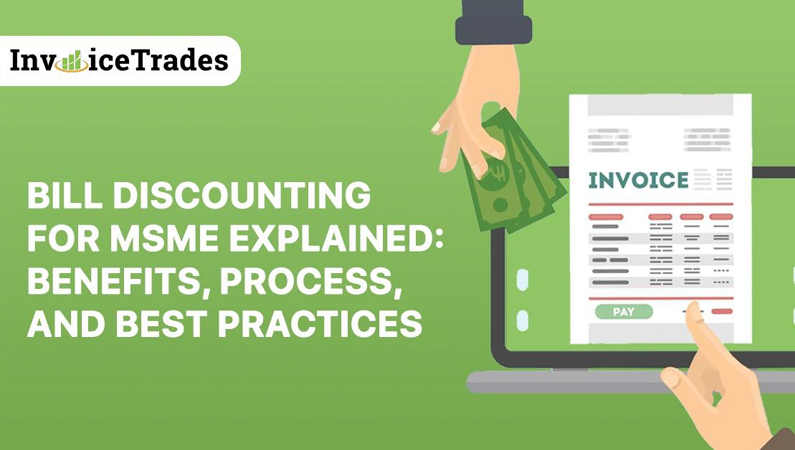Micro, Small, and Medium Enterprises (MSMEs) play a crucial role in driving economic growth by creating jobs, promoting innovation, and contributing to the GDP. However, one of the biggest challenges MSMEs face is managing cash flow, especially when payments from customers are delayed. To overcome this, many MSMEs turn to Bill Discounting as a practical solution to maintain liquidity and sustain operations. This blog explores everything you need to know about Bill Discounting for MSMEs, its benefits, process, and best practices to help your business thrive.
What is Bill Discounting for MSME?
Bill Discounting is a financial arrangement that allows MSMEs to convert their outstanding invoices into immediate cash. It is a form of short-term financing where a business sells its unpaid invoices to a financial institution at a discount in exchange for quick cash flow.
In the context of Bill Discounting for MSMEs, this solution empowers small businesses to manage their working capital more efficiently. Instead of waiting for customers to pay invoices, MSMEs can get immediate cash by leveraging their accounts receivable.
Key Players Involved in Bill Discounting for MSME:
- MSME (Seller): The business that raises the invoice.
- Buyer: The customer who owes payment to the MSME.
- Financial Institution: The bank or NBFC that provides the discounted cash.
Why is Bill Discounting Crucial for MSMEs?
For MSMEs, delayed payments can cause significant disruptions. Here’s how Bill Discounting for MSME can address these challenges:
- Immediate Cash Flow: MSMEs no longer need to wait for payment terms to expire. They can access cash immediately by discounting invoices.
- Reduced Dependence on Loans: Unlike traditional loans, bill discounting does not require additional collateral or create new debt.
- Business Growth: With improved liquidity, MSMEs can invest in new projects, manage daily operations, and seize growth opportunities.
Comparing traditional loans to Bill Discounting for MSMEs, the latter offers greater flexibility and quicker access to funds without increasing the business’s liabilities.
The Process of Bill Discounting for MSME
Here’s a step-by-step breakdown of how Bill Discounting for MSMEs works:
- Raise an Invoice: The MSME issues an invoice to the buyer for goods or services provided. This invoice serves as proof of the amount owed.
- Submit the Invoice for Discounting: The MSME approaches a financial institution or bank and submits the invoice for discounting. The institution verifies the invoice’s validity.
- Receive Discounted Payment: Once the invoice is verified, the financial institution advances a percentage of the invoice value to the MSME, typically 70-90%.
- Buyer Makes Payment to the Financial Institution: On the due date, the buyer pays the full invoice amount to the financial institution. The remaining balance, after deducting fees, is then paid to the MSME.
This simplified process makes Bill Discounting for MSMEs a quick and efficient way to improve cash flow.
Best Practices for MSMEs Using Bill Discounting
To maximize the benefits of Bill Discounting for MSMEs, here are some best practices to follow:
- Choose the Right Financial Partner: Select a reliable bank, NBFC, or fintech platform with competitive rates and a proven track record in bill discounting.
- Maintain Clear Documentation: Ensure that all invoices are accurate, complete, and legally compliant to avoid delays in the discounting process.
- Evaluate Costs: Understand the fees, discount rates, and other charges involved in Bill Discounting for MSMEs to avoid surprises.
- Monitor Cash Flow: Use the funds from bill discounting wisely to sustain operations and invest in growth opportunities.
- Build Strong Buyer Relationships: Maintain good relationships with your buyers to ensure timely payments, which can positively impact your Bill Discounting for MSME experience.
Challenges in Bill Discounting for MSMEs and How to Overcome Them
While Bill Discounting for MSMEs offers numerous benefits, there are some challenges to be aware of:
- Delayed Payments by Buyers: If buyers delay payments, it can affect the MSME’s cash flow. Solution: Work with trusted buyers and maintain open communication to ensure timely payments.
- High Discount Rates: Some financial institutions may charge high discount rates. Solution: Compare rates from multiple institutions and negotiate better terms.
- Limited Awareness: Many MSMEs are unaware of Bill Discounting for MSME solutions. Solution: Educate yourself and your team on the available options and their benefits.
Digital Platforms for Bill Discounting for MSME
With the rise of fintech platforms, Bill Discounting for MSMEs has become more accessible and efficient. Digital marketplaces allow MSMEs to submit invoices and receive payments faster without the lengthy paperwork involved in traditional banking.
Benefits of Digital Bill Discounting Platforms:
- Faster processing times.
- Greater transparency.
- Access to multiple financial institutions for competitive rates.
